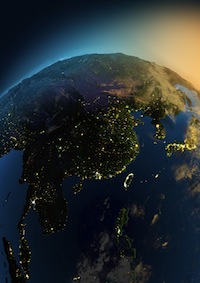China Takes a Vacation
How China is creating an infrastructure for a new consumption boom.
March 1, 2014

The statistics about the growth in Chinese consumption and leisure travel growth are impressive. Over the past 50 years, the country has come a long way.
Even so, those statistics are only numbers on a piece of paper. Seeing the trends play out in front of your own eyes is a different experience.
Living in a China for six months now, I see the trends behind the statistics. However, to witness one major trend for myself, I had to go outside China.
Westerners living in China have to get used to having no Christmas holiday in December. But the calendar does allow for a solid break around Chinese New Year, otherwise known as Spring Festival.
Where did the Chinese people go?
The spring festival was traditionally the celebration of the end of a farming cycle. People had free time during that period to honor family and ancestors. Set by the lunisolar calendar, the festival falls in the period between January 21 and February 20 on the Gregorian calendar.
Today, it is an opportunity for tens of millions of Chinese who have migrated to urban areas over recent decades to return to their ancestral homelands. They visit family members who did not join them in their risky venture to move into China’s swelling cities.
That explains why, to many ex-pats in major Chinese cities, Chinese New Year is jokingly known as the “where did all the Chinese people go?” holiday.
For students across China, spring festival is a coveted chance to return home for close to a month.
Within a few days after the end of semester exams in mid-January, my fellow international students at Peking University’s Shenzhen campus and I were the only ones left. A buzzing campus had turned into a ghost town within the space of a few days.
Out of China
If no one was to be found in China, we thought, why don’t we travel somewhere else in Asia? We booked a trip to the beach in the Philippines.
Stepping onto an airplane in Hong Kong bound for Manila, we saw a good number of Chinese tourists on the flight. The trend of increased leisure travel among upper middle class Chinese is well known. Our connecting discount airline flight from Manila to a beach destination was mostly filled with other young westerners.
However, sitting on the ferry to reach the island, I began to hear familiar Chinese words. Turning around, I realized that my friends and I were the only westerners. The ferry was otherwise filled entirely with Chinese tourists.
Our surprise only continued when we took a motorbike taxi to our hostel. Driving along the main road on the island, we saw plenty of Chinese characters advertising Chinese restaurants. The New Year red lamps that are put up in public on the Chinese mainland shone everywhere on the island.
Consumerism shifts east
Over the next few days, I continued to hear those same familiar words. We were actually witnessing a profound shift in global consumption trends.
Local Filipinos offered massage on the beach using the Chinese word for massage. Large groups of Chinese tourists walked around the island. Young Chinese couples took pictures of the sunset, while Chinese grandparents watched their grandchildren play on the beach for the first time.
These are scenes that up until recently have been reserved for westerners. But now, due to the sheer numerical power and the financial prowess of Chinese consumers, joined by Koreans and other East Asians, a very different picture is unfolding.
It seemed about half of the total tourist population on the island during my trip was made up of mainland Chinese. Granted, I visited during the time of year when the highest number of Chinese takes off work to travel.
But the year-round infrastructure catering to Chinese tourists that is forming – Chinese words used by locals and more Chinese restaurants – suggest that a strong trend has taken hold and the local market is responding to take advantage of it.
Of course, one also sees more and more Chinese on vacation in the west, visiting the famous landmarks from Paris to New York. Closer to China, though, a picture of Chinese regional domination in the economic and consumer sphere is emerging.
Takeaways
To ex-pats, Chinese New Year is known as the "where did all the Chinese people go?" holiday.
The Chinese New Year red lamps that deck the mainland shone everywhere on the island in the Philippines.
The numbers and financial prowess of Chinese consumers are painting a different picture of regional tourism.
Read previous

TTIP: Getting Past “No”
February 27, 2014
